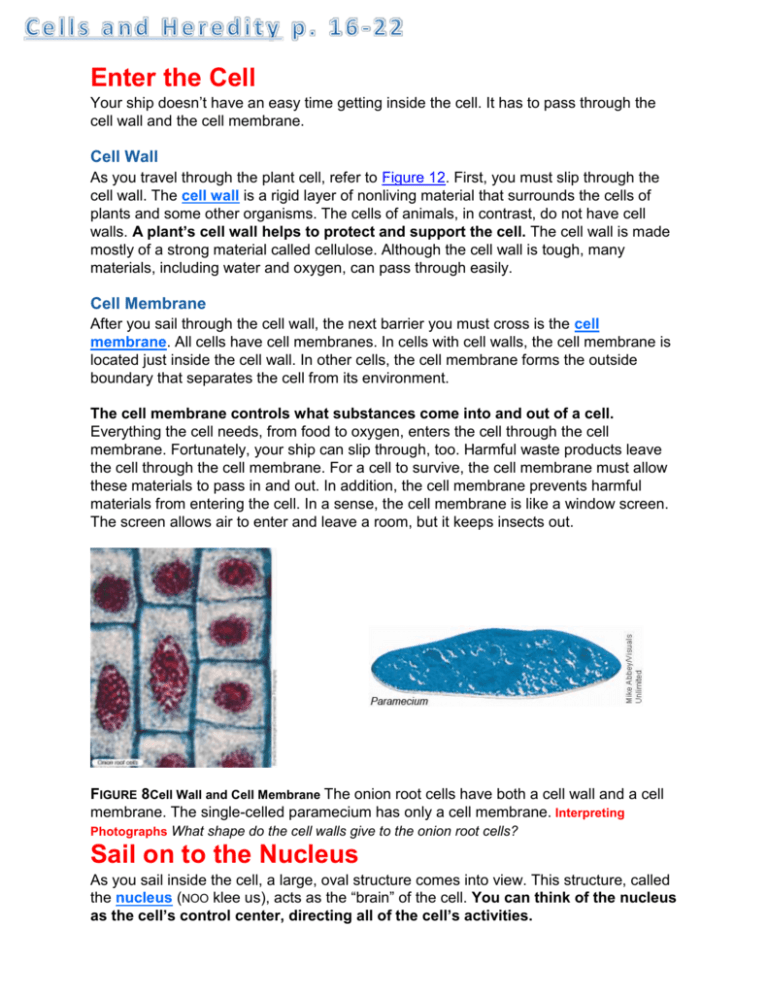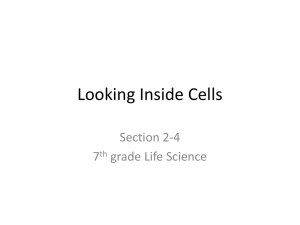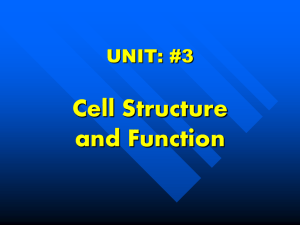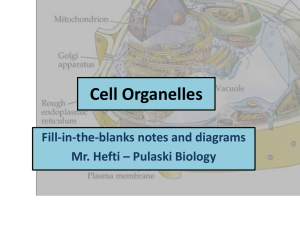Cells and Heredity p. 16-22
advertisement

Enter the Cell Your ship doesn’t have an easy time getting inside the cell. It has to pass through the cell wall and the cell membrane. Cell Wall As you travel through the plant cell, refer to Figure 12. First, you must slip through the cell wall. The cell wall is a rigid layer of nonliving material that surrounds the cells of plants and some other organisms. The cells of animals, in contrast, do not have cell walls. A plant’s cell wall helps to protect and support the cell. The cell wall is made mostly of a strong material called cellulose. Although the cell wall is tough, many materials, including water and oxygen, can pass through easily. Cell Membrane After you sail through the cell wall, the next barrier you must cross is the cell membrane. All cells have cell membranes. In cells with cell walls, the cell membrane is located just inside the cell wall. In other cells, the cell membrane forms the outside boundary that separates the cell from its environment. The cell membrane controls what substances come into and out of a cell. Everything the cell needs, from food to oxygen, enters the cell through the cell membrane. Fortunately, your ship can slip through, too. Harmful waste products leave the cell through the cell membrane. For a cell to survive, the cell membrane must allow these materials to pass in and out. In addition, the cell membrane prevents harmful materials from entering the cell. In a sense, the cell membrane is like a window screen. The screen allows air to enter and leave a room, but it keeps insects out. FIGURE 8Cell Wall and Cell Membrane The onion root cells have both a cell wall and a cell membrane. The single-celled paramecium has only a cell membrane. Interpreting Photographs What shape do the cell walls give to the onion root cells? Sail on to the Nucleus As you sail inside the cell, a large, oval structure comes into view. This structure, called the nucleus (NOO klee us), acts as the “brain” of the cell. You can think of the nucleus as the cell’s control center, directing all of the cell’s activities. Nuclear Envelope Notice in Figure 9 that the nucleus is surrounded by a membrane called the nuclear envelope. Just as a mailing envelope protects the letter inside it, the nuclear envelope protects the nucleus. Materials pass in and out of the nucleus through pores in the nuclear envelope. So aim for that pore just ahead and carefully glide into the nucleus. FIGURE 9The Nucleus The photo and diagram both show the nucleus, which is the cell’s control center. The chromatin in the nucleus contains instructions for carrying out the cell’s activities. Chromatin You might wonder how the nucleus “knows” how to direct the cell. The answer lies in those thin strands floating directly ahead in the nucleus. These strands, called chromatin, contain genetic material, the instructions for directing the cell’s functions. For example, the instructions in the chromatin ensure that leaf cells grow and divide to form more leaf cells. Nucleolus As you prepare to leave the nucleus, you spot a small object floating by. This structure, a nucleolus, is where ribosomes are made. Ribosomes are the organelles where proteins are produced. Proteins are important chemicals in cells. Organelles in the Cytoplasm As you leave the nucleus, you find yourself in the cytoplasm, the region between the cell membrane and the nucleus. Your ship floats in a clear, thick, gel-like fluid. The fluid in the cytoplasm is constantly moving, so your ship does not need to propel itself. Many cell organelles are found in the cytoplasm. Mitochondria Suddenly, rod-shaped structures loom ahead. These organelles are mitochondria (my tuh KAHN dree uh) (singular mitochondrion). Mitochondria are known as the “powerhouses” of the cell because they convert energy in food molecules to energy the cell can use to carry out its functions. Figure 10 shows a mitochondrion up close. FIGURE 10Mitochondrion The mitochondria produce most of the cell’s energy. Inferring In what types of cells would you expect to find a lot of mitochondria? Endoplasmic Reticulum As you sail farther into the cytoplasm, you find yourself in a maze of passageways called the endoplasmic reticulum (en duh PLAZ mik rih TIK yuh lum). The endoplasmic reticulum’s passageways carry proteins and other materials from one part of the cell to another. FIGURE 11Endoplasmic Reticulum The endoplasmic reticulum is similar to the system of hallways in a building. Proteins and other materials move throughout the cell by way of the endoplasmic reticulum. The spots on this organelle are ribosomes, which produce proteins. Ribosomes Attached to some surfaces of the endoplasmic reticulum are small, grainlike bodies called ribosomes. Other ribosomes float in the cytoplasm. Ribosomes function as factories to produce proteins. Some newly made proteins are released through the wall of the endoplasmic reticulum. From the interior of the endoplasmic reticulum, the proteins will be transported to the Golgi bodies. Plant Cell FIGURE 12Animal Cell These illustrations show typical structures found in plant and animal cells. Comparing And Contrasting Identify one structure found in plant cells but not animal cells. For: Plant and Animal Cells activity Visit: PHSchool.com Web Code: cep-3012 Golgi Bodies As you leave the endoplasmic reticulum, you see the structure shown in Figure 13. It looks like flattened sacs and tubes. This structure, called a Golgi body, can be thought of as the cell’s mail room. The Golgi bodies receive proteins and other newly formed materials from the endoplasmic reticulum, package them, and distribute them to other parts of the cell. The Golgi bodies also release materials outside the cell. FIGURE 13A Golgi Body Golgi bodies are organelles that transport materials. Chloroplasts Have you noticed the many large green structures floating in the cytoplasm? Only the cells of plants and some other organisms have these green organelles called chloroplasts. Chloroplasts capture energy from sunlight and use it to produce food for the cell. Chloroplasts make leaves green. Vacuoles Steer past the chloroplasts and head for that large, water-filled sac, called a vacuole (VAK yoo ohl), floating in the cytoplasm. Vacuoles are the storage areas of cells. Most plant cells have one large vacuole. Some animal cells do not have vacuoles; others do. Vacuoles store food and other materials needed by the cell. Vacuoles can also store waste products. Lysosomes Your journey through the cell is almost over. Before you leave, take another look around you. If you carefully swing your ship around the vacuole, you may be lucky enough to see a lysosome (LY suh sohm). Lysosomes are small, round structures containing chemicals that break down certain materials in the cell. Some chemicals break down large food particles into smaller ones. Lysosomes also break down old cell parts and release the substances so they can be used again. In this sense, you can think of lysosomes as the cell’s cleanup crew. Specialized Cells Plants and animals (including yourself) contain many cells. In a many-celled organism, the cells are often quite different from each other and are specialized to perform specific functions. Contrast, for example, the nerve cell and red blood cells in Figure 14. Nerve cells are specialized to transmit information from one part of your body to another, and red blood cells carry oxygen throughout your body. FIGURE 14Specialized Cells Nerve cells carry information throughout the human body. Red blood cells carry oxygen. Bone cells produce chemicals that strengthen bone. Comparing And Contrasting Compare the structures of these three types of cells. In many-celled organisms, cells are often organized into tissues, organs, and organ systems. A tissue is a group of similar cells that work together to perform a specific function. For example, your brain is made mostly of nervous tissue, which consists of nerve cells. An organ, such as your brain, is made of different kinds of tissues that function together. In addition to nervous tissue, the brain contains other kinds of tissue that support and protect it. Your brain is part of your nervous system, which is an organ system that directs body activities and processes. An organ system is a group of organs that work together to perform a major function.








